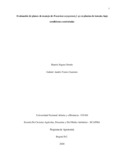Please use this identifier to cite or link to this item:
https://repository.unad.edu.co/handle/10596/36796Full metadata record
| DC Field | Value | Language |
|---|---|---|
| dc.contributor.advisor | Girón Mendieta; Jorge Antonio | - |
| dc.coverage.spatial | cead_-_josé_acevedo_y_gómez | spa |
| dc.creator | Segura Osorio, Beatriz | - |
| dc.creator | Torres Guerrero, Gabriel Andrés | - |
| dc.date.accessioned | 2020-10-14T03:25:45Z | - |
| dc.date.available | 2020-10-14T03:25:45Z | - |
| dc.date.created | 2020-10-11 | - |
| dc.identifier.uri | https://repository.unad.edu.co/handle/10596/36796 | - |
| dc.description.abstract | El cultivo de tomate Solanum lycopersicum es uno de los más importantes en Colombia , su producción registrada en el 2018 fue de 632.268 toneladas, se debe tener en cuenta que esta producción está relacionada con el amplio rango de condiciones agroclimáticas que ofrece el país haciendo posible su producción durante todo año, ya sea en campo abierto o en invernaderos, se puede cultivar a partir de los 800 hasta los 2400 m.s.n.m; Este se ve afectado por el hongo Fusarium oxysporum f debido a las condiciones ambientales e inadecuados métodos implementados para su control, generando gran severidad de ataque en los cultivos, estas condiciones favorecen su desarrollo y capacidad de infectar y diseminarse por toda la planta, El hongo se caracteriza por producir colonias de crecimiento rápido y tres tipos de esporas: microconidias, macroconidias y clamidosporas, este puede sobrevivir en el suelo como Micelio o como esporas en ausencia de sus hospederos. Se disemina a distancias cortas, mediante el agua, equipos agrícolas y herramientas infectadas por el hongo y a distancias largas, por medio de plantas enfermas o suelo adherido a ellas. El objetivo de este trabajo es determinar la eficacia de algunos métodos accesibles y sencillos utilizados para controlar la enfermedad en los cultivos. En este trabajo se realizaron aplicaciones de tratamientos de síntesis química, enmiendas agricolas y biológicos en el suelo con material vegetal de tomate (Lycopersicum esculentum) variedad Calima donde se evaluaron 6 tratamientos T0 testigo absoluto; T1 Cal dolomita; T2 Nitrógeno amoniacal; T3 Trichoderma Harzuarium; T4 Fungicida de sintesis química y T5 Cal dolomita con Trichoderma harzuarium. Para identificar la afectación del patógeno en el material vegetal estudiado, las variables que se evaluaron fueron Crecimiento, números de hojas, incidencia (afectación), pasado 75 días se midió longitud de raíz y peso seco total. Los resultados aluden que suministrar nitrógeno amoniacal al suelo puede posiblemente aumentar la severidad del hongo, a su vez se encontró que el T1 presento mejores resultados de crecimiento y desarrollo radicular. Los resultados concluyen que no se logró establecer cuál es el manejo más efectivo para Fusarium oxysporum pero se resalta la importancia de la utilización de enmiendas, ya que se pudo observar durante este estudio que los tratamientos en donde se utilizó cal presentaron mejores resultados en las variables medidas, longitud de tallo, número de hojas, afectación, peso seco total. | spa |
| dc.format | ||
| dc.title | Evaluación de planes de manejo de Fusarium Oxysporum F. SP en plantas de tomate, bajo condiciones controladas. | |
| dc.type | Proyecto de investigación | |
| dc.subject.keywords | Hongo, Tomate, Fusarium, Nitrógeno, Patógeno. | spa |
| dc.description.abstractenglish | The tomato Solanum lycopersicum farming, is one of the most important farming in Colombia, its production was registered in 2018 was for 632.268 tonnes, it should be taken into account that this production is related to the wide range of agro-climatic conditions that the country offers, making its production possible throughout the year, either in the open field or in greenhouses, it can be grown from 800 to 2400 amsl; This is affected by the fungus Fusarium oxysporum f, due to environmental conditions and inadequate methods implemented for its control, generating great severity of attack on crops, these conditions favor their development and ability to infect and spread throughout the plant, the fungus is characterized by producing fast-growing colonies and three types of spores: microconidia, macroconidia and chlamydosporas, this can survive in the soil as mycelium or as spores in the absence of its hosts. It is spread over short distances, through water, agricultural equipment and tools infected with the fungus, and over long distances, through diseased plants or soil attached to them. The objective of this work is to determine the efficacy of some accessible and simple methods used to control the disease in crops. In this work, applications of chemical synthesis treatments, agricultural and biological amendments were made in the soil with tomato plant material (Lycopersicum esculentum) variety Calima where 6 treatments T0 absolute control were evaluated; T1 Dolomite lime; T2 Ammonia nitrogen; T3 Trichoderma Harzuarium; T4 Chemical synthetic fungicide and T5 Dolomite lime with Trichoderma harzuarium. To identify the affectation of the pathogen in the studied plant material, the variables that were evaluated were Growth, number of leaves, incidence (affectation), after 75 days, root length and total dry weight. The results indicate that supplying ammonia nitrogen to the soil can possibly increase the severity of the fungus. In turn, it was found that T1 presented better growth and radicular development results. The results conclude that it was not possible to establish which is the most effective management for Fusarium oxysporum, but the importance of the use of amendments is highlighted since it was observed during this study that the treatments in which lime was used presented better results in the variables measurements, stem length, number of leaves, affectation, total dry weight. | spa |
| dc.subject.category | Agronomía | spa |
| Appears in Collections: | Agronomía | |
Files in This Item:
| File | Description | Size | Format | |
|---|---|---|---|---|
| bsegurao.pdf | 1.5 MB | Adobe PDF |  View/Open |
Items in DSpace are protected by copyright, with all rights reserved, unless otherwise indicated.
